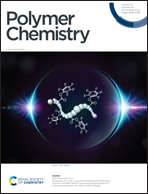Solvent-free synthesis of a formaldehyde-free benzoxazine monomer: study of its curing acceleration effect for commercial benzoxazine†
Abstract
Polybenzoxazines are very interesting phenolic resins that are obtained by ring-opening polymerisation (ROP) of benzoxazine monomers. However, commercially available resins such as bisphenol A-aniline benzoxazine (BA-a) have found limited industrial applications, partly due to their high ROP temperature. To tackle this limitation, we designed a 2-substituted benzoxazine monomer bearing a phenol, Ph-fa[2]PhOH, which was obtained by different methods of solvent-free and environmentally friendly synthesis, such as ball-milling and bladeless planetary mixing. The phenol functionalisation leads to a high reactivity, thanks to the hydrogen-bond activation of the oxazine ring. Ph-fa[2]PhOH showed one of the lowest ROP temperatures ever reported (ca. 160 °C) and a low activation energy (Eα) of 40–70 kJ mol−1 as determined by the Vyazovkin kinetic method. The high reactivity of this monomer was advantageously exploited for the reduction of the ROP temperature of the commercial BA-a benzoxazine. By studying the curing process by non-isothermal DSC after different polymerisation stages of a formulation containing 10 wt% of our new monomer with BA-a precursors, we were able to evaluate its acceleration effect. In addition, we showed that Ph-fa[2]PhOH was able to improve the Tα of the crosslinked network by 10 °C and the char yield by 10%, leading to a significant improvement in the properties of the commercial BA-a resin.



 Please wait while we load your content...
Please wait while we load your content...